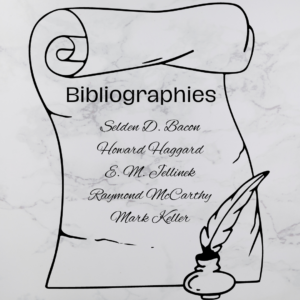 Picking up where our previous post, Author bibliographies: The process left off, i.e., the first source special to alcohol studies, let’s round up some more general source ideas.
Picking up where our previous post, Author bibliographies: The process left off, i.e., the first source special to alcohol studies, let’s round up some more general source ideas.
Help from the library: the OPAC
An obvious source to compile any bibliography is the library’s OPAC (Online Public Access Catalog). If we are lucky, creative federated searches in a large collection will retrieve quite a few results. Many of these texts are becoming available online, either from large databases or from individual journals, as more and more backfiles have been digitized and made available through subscriptions. In our case, the Journal of Studies of Alcohol and Drugs has its entire publication digitized, including the earliest issues of the Quarterly Journal of Studies on Alcohol, which was launched in 1940 at Yale and moved to Rutgers in 1962. We also have the luxury of having the full print run available in the library, and at the Center of Alcohol and Substance Use Studies.
Also from the library: ILL and document delivery
For verification purposes, the interlibrary loan and documentary delivery service from our local library is indispensable. If a record can be located in the catalog, it takes only a few clicks to reach the page where one can request document delivery without typing in any further information, as all the fields are conveniently populated by the system for the user. The same delivery system can be used for items with no bibliographic record in the catalog. In this instance, one needs to fill out the form with a few mandatory fields, including the most relevant pieces of information. A special “note” field also allows patrons to provide more information about the source of the record, which, in our case, was used more than once, as we were dealing with data harvested from multiple sources.
Footnote chasing
In addition to existing bibliographies, publications by the same author are a good starting point. Whether for vanity or in place of better sources, authors tend to cite their own work or those of their immediate colleagues rather generously. In our experience, when looking at the early years of alcohol studies, it is not unusual to see scholarly and popular publications, including reports, white papers, pamphlets, and magazine articles cited among the references. With some footnote chasing, our chances to add a few more items to the original bibliography grew exponentially.
 Publication catalogs
Publication catalogs
Another great source, if we can find any in digital collections, is contemporary publication catalogs. In early alcohol studies, the Yale and Rutgers CAS were major publishers of addiction science literature, and these publication catalogs are treasure troves of information. They often helped us add more to the researcher’s bibliography. Geared toward diverse audiences, these catalogs contained “popular, technical, and non-technical books, pamphlets, and reprints on all aspects of alcohol problems,” according to their advertisements. They can provide invaluable information about the mere existence of reprinted and republished items by date.
When trouble knocks
What to do with the so-called problem items? This category covers diverse publications, including articles and book chapters in foreign languages, rare, obscure, or discontinued publications in English, republished or reprinted items, and numerous book reviews, which are marked with initials rather than a clear author attribution. This is where the fun starts! Embarking on a journey to track down problem items sounds exciting. In reality, it’s a long and often unfruitful procedure, with many dead-end inquiries in spite of the efforts of helpful librarian colleagues all over the world. These are the records with a little asterisk after them, denoting a “to be verified” clause.
Results
The results of this kind of detective work are incredibly rewarding. Looking at the sheer amount of publications on the list we started with and comparing it to the final bibliography will silence the naysayers right away. Views and download counts of the published versions also justify the efforts. From those one can only speculate on any further use of the individual records, now verified, as well as the subsequent contributions to the history of alcohol studies. Both the feedback and reference requests from scholars received so far are positive and inspiring, and continue to contribute to the field. If we, who know the works of these researchers, don’t do it, who is going to?
Read parts 1-3: Author bibliographies in alcohol studies
Published author bibliographies (with introductory articles)
- Ward, J. H., & Bejarano, W. (2016). A tribute to Bunky at 125: A comprehensive bibliography of E. M. Jellinek’s publications.Journal of Studies on Alcohol and Drugs, 77, 371–374.
- Allred, N., Bejarano, W., & Ward, J. (2017). Howard Wilcox Haggard and the Institutionalization of Modern Alcohol Studies. Journal of Studies on Alcohol and Drugs, 78(2), 325-329.
- Allred, N., Bejarano, W., & Ward, J. H. (2023). A Sociologist and the Problems of Alcohol Studies: The Life and Legacy of Selden D. Bacon. Journal of Studies on Alcohol and Drugs, 84(5), 791–796.